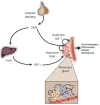The contribution of growth hormone to mammary neoplasia
- PMID: 18253708
- PMCID: PMC2665193
- DOI: 10.1007/s10911-008-9070-z
The contribution of growth hormone to mammary neoplasia
Abstract
While the effects of growth hormone (GH) on longitudinal growth are well established, the observation that GH contributes to neoplastic progression is more recent. Accumulating literature implicates GH-mediated signal transduction in the development and progression of a wide range malignancies including breast cancer. Recently autocrine human GH been demonstrated to be an orthotopically expressed oncogene for the human mammary gland. This review will highlight recent evidence linking GH and mammary carcinoma and discuss GH-antagonism as a potential therapeutic approach for treatment of breast cancer.
Figures



Similar articles
-
Morphogenic and tumorigenic potentials of the mammary growth hormone/growth hormone receptor system.Mol Cell Endocrinol. 2002 Nov 29;197(1-2):153-65. doi: 10.1016/s0303-7207(02)00259-9. Mol Cell Endocrinol. 2002. PMID: 12431808 Review.
-
Autocrine human growth hormone promotes tumor angiogenesis in mammary carcinoma.Endocrinology. 2009 Mar;150(3):1341-52. doi: 10.1210/en.2008-0608. Epub 2008 Oct 30. Endocrinology. 2009. PMID: 18974274
-
Mammary Tumors Growing in the Absence of Growth Hormone Are More Sensitive to Doxorubicin Than Wild-Type Tumors.Endocrinology. 2021 Apr 1;162(4):bqab013. doi: 10.1210/endocr/bqab013. Endocrinology. 2021. PMID: 33475144 Free PMC article.
-
Progestin-induced mammary growth hormone (GH) production.Adv Exp Med Biol. 2000;480:71-6. doi: 10.1007/0-306-46832-8_8. Adv Exp Med Biol. 2000. PMID: 10959411 Review.
-
DNMT3A and DNMT3B mediate autocrine hGH repression of plakoglobin gene transcription and consequent phenotypic conversion of mammary carcinoma cells.Oncogene. 2008 Apr 17;27(18):2602-12. doi: 10.1038/sj.onc.1210917. Epub 2007 Nov 12. Oncogene. 2008. PMID: 17998942
Cited by
-
The growth hormone receptor: mechanism of activation and clinical implications.Nat Rev Endocrinol. 2010 Sep;6(9):515-25. doi: 10.1038/nrendo.2010.123. Epub 2010 Jul 27. Nat Rev Endocrinol. 2010. PMID: 20664532 Review.
-
Autocrine/Paracrine Human Growth Hormone-stimulated MicroRNA 96-182-183 Cluster Promotes Epithelial-Mesenchymal Transition and Invasion in Breast Cancer.J Biol Chem. 2015 May 29;290(22):13812-29. doi: 10.1074/jbc.M115.653261. Epub 2015 Apr 14. J Biol Chem. 2015. PMID: 25873390 Free PMC article.
-
Growth hormone receptor antagonism downregulates ATP-binding cassette transporters contributing to improved drug efficacy against melanoma and hepatocarcinoma in vivo.Front Oncol. 2022 Jul 5;12:936145. doi: 10.3389/fonc.2022.936145. eCollection 2022. Front Oncol. 2022. PMID: 35865483 Free PMC article.
-
Growth Hormone Receptor Knockdown Sensitizes Human Melanoma Cells to Chemotherapy by Attenuating Expression of ABC Drug Efflux Pumps.Horm Cancer. 2017 Jun;8(3):143-156. doi: 10.1007/s12672-017-0292-7. Epub 2017 Mar 14. Horm Cancer. 2017. PMID: 28293855 Free PMC article.
-
Reciprocal occupancy of BCL6 and STAT5 on Growth Hormone target genes: contrasting transcriptional outcomes and promoter-specific roles of p300 and HDAC3.Mol Cell Endocrinol. 2014 Sep;395(1-2):19-31. doi: 10.1016/j.mce.2014.07.020. Epub 2014 Aug 1. Mol Cell Endocrinol. 2014. PMID: 25088465 Free PMC article.
References
-
- Salomon DS, Lewis MT. Embryogenesis and oncogenesis: Dr Jekyll and Mr Hyde. J Mammary Gland Biol Neoplasia. 2004;9(2):105–7. - PubMed
-
- Kleinberg DL. Early mammary development: growth hormone and IGF-1. J Mammary Gland Biol Neoplasia. 1997;2(1):49–57. - PubMed
-
- Le Roith D, Bondy C, Yakar S, Liu JL, Butler A. The somatomedin hypothesis: 2001. Endocr Rev. 2001;22(1):53–74. - PubMed
-
- Zhu T, Goh EL, Graichen R, Ling L, Lobie PE. Signal transduction via the growth hormone receptor. Cell Signal. 2001;13(9):599–616. - PubMed
Publication types
MeSH terms
Substances
LinkOut - more resources
Full Text Sources
Medical

